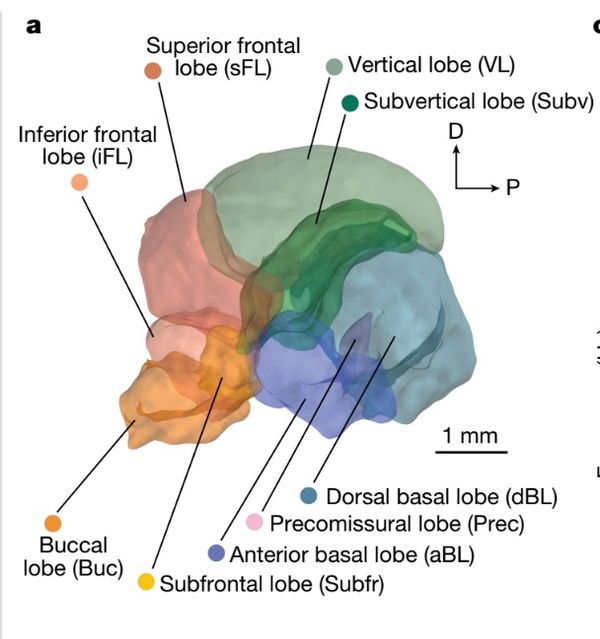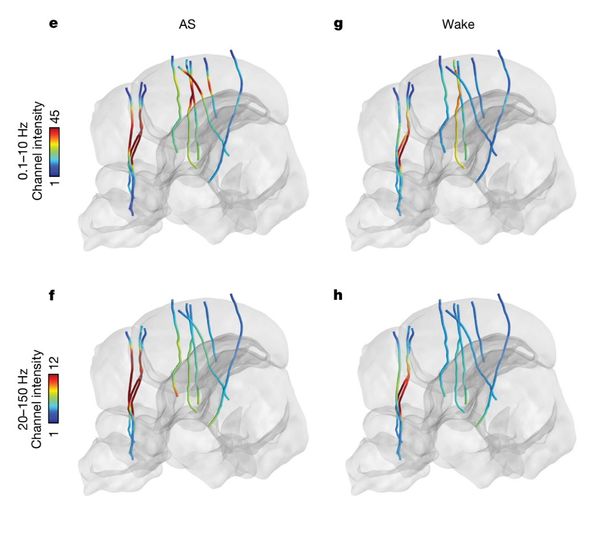
If you're lucky enough to see a shallow-water octopus bedding down in a craggy nook off the coast of Okinawa Island — and you have the patience to wait about an hour after it falls asleep — you might see its dreams flash on the surface of its chameleon-like, color-changing skin. Although the creatures' brains are different enough from mammals that we can't say for certain whether they're actually dreaming, researchers have now mapped out a two-stage sleep cycle in octopuses. And, at first glance, their fitful sleep-flashes resemble the adorable twitching of a snoozing dog chasing rabbits in its sleep.
More than 500 million years of evolution has separated octopuses from humans, but the complex brains of sea creatures share a common feature with mammals when they sleep. Like mammals, they have distinct phases of sleep that are "active" and "quiet." But when octopuses fall into quiet periods of sleep, they will sometimes burst suddenly into a short, frenzied period of activity where their skin flashes colorfully.
More than 500 million years of evolution has separated octopuses from humans, but the complex brains of sea creatures share a common feature with mammals when they sleep.
While mapping the brain activity of the animals, researchers from Okinawa Institute of Science and Technology (OIST) have discovered that those wake-like periods resemble the Rapid Eye Movement (REM) stage of human sleep. And that discovery could teach us about the common traits of all animals on earth with complex brain development. Their research was published in the journal Nature.
"The fact that two-stage sleep has independently evolved in distantly related creatures, like octopuses, which have large but completely different brain structures from vertebrates, suggests that possessing an active, wake-like stage may be a general feature of complex cognition," said University of Washington's Dr. Leenoy Meshulam in a statement.
During her three-month stay at OIST, Meshulam helped design the research on octopus sleep cycles and co-authored the study. They chose nocturnal octopuses (Octopus laqueus) for their subject, a small tropical species that can be found near Okinawa, Japan and the greater Indo-Pacific. When these creatures close their eyes during the day, they adopt "a flat resting posture and a uniformly white skin pattern," the authors write.
After prodding the octopuses with an electrified metal coil at different stages of sleeping and wakefulness, they got a baseline on their response sensitivity. The researchers next dove into the animals' brain activity using silicon neural probes, which allowed them to render the experiment into a 3D "brain atlas."
The excitement of the sleep study revolves around the octopuses' dazzling displays as they snooze.
What they found is a surprising similarity between invertebrates and us spine-endowed land dwellers. Mammals show a certain type of burstlike signals in the brain, known as sleep spindles, when we're in a non-REM stage of deep slumber. Scientists still aren't exactly sure what these waveforms do for us in our sleep, but one theory is that they help us consolidate memories, or shuffling the short-term memories to the long-term.
Following OIST research, though, we now know that octopus brains show waveforms that closely resemble our sleep spindles during the animals' quiet-sleep stages. And those waveforms are actually happening in a section of their brains that are tied to memory and learning.

The excitement of the sleep study, however, revolves around the octopuses' dazzling displays as they snooze. Many cephalopods, a group which includes octopuses, squids and cuttlefish, can shift their hue at will, thanks to individual pigment cells that work together to create an abstract and swirling montage of color and texture across their skin.
But during one minute bursts of colorful activity — which included "pronounced eye and body movements," as the authors describe it — O. laqueus would turn red or yellow. These patterns don't appear random. Indeed, they seem to map onto similar colors and displays used when these animals hunt, mate or warn others of predators.
There are any number of reasons why the creatures could be cycling through their greatest hits during sleep — like subconsciously practicing their patterns, or reflexively keeping those pigment cells moving and alive. Or they could be discharging and processing patterns they learned and used that day. In other words, they could be dreaming. Either way, the display offers researchers a unique and valuable way to study sleep and cognition.
"In this sense, while humans can verbally report what kind of dreams they had only once they wake, the octopuses' skin pattern acts as a visual readout of their brain activity during sleep," said the study's senior author, Prof. Sam Reiter, who leads the Computational Neuroethology Unit at OIST.
"All animals seem to show some form of sleep, even simple animals like jellyfish and fruit flies. But for a long time, only vertebrates were known to cycle between two different sleep stages," he said in a release.

Reiter hasn't yet said whether he thinks the octopuses are reflexively shifting skin patterns or if they're dreaming, chasing oysters in their sleep like dogs chase rabbits. "We currently don't know which of these explanations, if any, could be correct. We are very interested in investigating further," he said.
What's remarkable about this is how human-like this activity in the octopus brain is. And this is far from the only recent study to demonstrate neurological similarities between us and octopuses. A new report in the journal Current Biology found that humans and octopuses map their visual landscape in very similar ways. Despite the fact that octopuses and humans evolved into our separate niches literally half a billion years ago, there are a ton of things we share in common, especially when it comes to intelligence.







